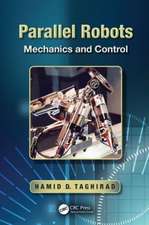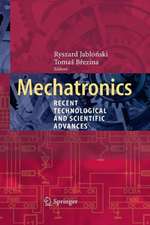Perturbation Techniques for Flexible Manipulators: The Springer International Series in Engineering and Computer Science, cartea 138
Autor Anthony R. Fraser, Ron W. Danielen Limba Engleză Hardback – 30 iun 1991
| Toate formatele și edițiile | Preț | Express |
|---|---|---|
| Paperback (1) | 944.51 lei 6-8 săpt. | |
| Springer Us – 9 oct 2012 | 944.51 lei 6-8 săpt. | |
| Hardback (1) | 951.14 lei 6-8 săpt. | |
| Springer Us – 30 iun 1991 | 951.14 lei 6-8 săpt. |
Din seria The Springer International Series in Engineering and Computer Science
- 24%
 Preț: 1041.97 lei
Preț: 1041.97 lei - 20%
 Preț: 643.50 lei
Preț: 643.50 lei - 18%
 Preț: 1225.62 lei
Preț: 1225.62 lei - 18%
 Preț: 965.02 lei
Preț: 965.02 lei - 20%
 Preț: 646.12 lei
Preț: 646.12 lei - 18%
 Preț: 948.79 lei
Preț: 948.79 lei - 20%
 Preț: 646.62 lei
Preț: 646.62 lei - 15%
 Preț: 637.46 lei
Preț: 637.46 lei - 20%
 Preț: 643.83 lei
Preț: 643.83 lei - 18%
 Preț: 949.23 lei
Preț: 949.23 lei - 20%
 Preț: 644.48 lei
Preț: 644.48 lei - 20%
 Preț: 994.92 lei
Preț: 994.92 lei - 20%
 Preț: 645.97 lei
Preț: 645.97 lei - 18%
 Preț: 946.87 lei
Preț: 946.87 lei - 20%
 Preț: 995.57 lei
Preț: 995.57 lei - 18%
 Preț: 956.99 lei
Preț: 956.99 lei - 20%
 Preț: 644.98 lei
Preț: 644.98 lei - 15%
 Preț: 649.54 lei
Preț: 649.54 lei - 18%
 Preț: 950.21 lei
Preț: 950.21 lei - 18%
 Preț: 1221.38 lei
Preț: 1221.38 lei - 18%
 Preț: 957.62 lei
Preț: 957.62 lei - 15%
 Preț: 643.99 lei
Preț: 643.99 lei - 18%
 Preț: 948.47 lei
Preț: 948.47 lei - 18%
 Preț: 947.35 lei
Preț: 947.35 lei - 20%
 Preț: 1284.65 lei
Preț: 1284.65 lei - 20%
 Preț: 1628.31 lei
Preț: 1628.31 lei - 20%
 Preț: 1285.78 lei
Preț: 1285.78 lei
Preț: 951.14 lei
Preț vechi: 1159.94 lei
-18% Nou
Puncte Express: 1427
Preț estimativ în valută:
181.100€ • 190.53$ • 150.59£
181.100€ • 190.53$ • 150.59£
Carte tipărită la comandă
Livrare economică 05-19 aprilie
Preluare comenzi: 021 569.72.76
Specificații
ISBN-13: 9780792391623
ISBN-10: 0792391624
Pagini: 275
Ilustrații: XVII, 275 p.
Dimensiuni: 155 x 235 x 23 mm
Greutate: 0.61 kg
Ediția:1991
Editura: Springer Us
Colecția Springer
Seria The Springer International Series in Engineering and Computer Science
Locul publicării:New York, NY, United States
ISBN-10: 0792391624
Pagini: 275
Ilustrații: XVII, 275 p.
Dimensiuni: 155 x 235 x 23 mm
Greutate: 0.61 kg
Ediția:1991
Editura: Springer Us
Colecția Springer
Seria The Springer International Series in Engineering and Computer Science
Locul publicării:New York, NY, United States
Public țintă
ResearchCuprins
1 Introduction.- 1.1 Objectives.- 1.2 Book outline.- 2 Present trends in the dynamics and control of flexible manipulators.- 2.1 Introduction.- 2.2 Space Structures.- 2.3 Dynamics of flexible manipulators.- 2.4 Control of flexible manipulators.- 2.5 Conclusions.- 3 Dynamic model of a single-link flexible manipulator.- 3.1 Introduction.- 3.2 Analytic model of a single-link arm.- 3.3 Dynamic model based on natural modes.- 3.4 Dynamic models based on assumed modes.- 3.5 Models for control design.- 3.6 Conclusions.- 4 An experimental single-link flexible arm.- 4.1 Introduction.- 4.2 Experimental apparatus.- 4.3 Experimental identification of the system model.- 4.4 Verification of the arm model.- 4.5 Conclusions.- 5 Control design for the single-link arm.- 5.1 Introduction.- 5.2 Digital control design.- 5.3 Experimental flexible arm control.- 5.4 Conclusions.- 6 Multi-link flexible arm dynamics.- 6.1 Introduction.- 6.2 Dynamic model of a planar two-link flexible arm.- 6.3 Linearisation of the dynamic model.- 6.4 Properties of the linearised model.- 6.5 Variation of the linearised model with loading and configuration.- 6.6 Gravitational effects.- 6.7 Control of multi-link manipulators.- 6.8 Conclusions.- 7 A perturbation approach to changing dynamics.- 7.1 Introduction.- 7.2 Canonical perturbation theory.- 7.3 Extension of canonical perturbation theory to flexible systems.- 7.4 Perturbation analysis based on orthogonality of modes.- 7.5 Assumed modes formulation.- 7.6 Conclusions.- 8 Extended perturbation techniques.- 8.1 Introduction.- 8.2 Extended perturbation analysis.- 8.3 Discrete-time perturbation analysis.- 8.4 Corrective control design.- 8.5 Explicit control correction.- 8.6 Direct update of controller gains.- 8.7 Investigation of corrective control on the two-link arm model.- 8.8 A general perturbation-based control scheme.- 8.9 Conclusions.- 9 Looking to the future - high performance control.- 9.1 Introduction.- 9.2 Controller Design.- 9.3 The Provision of Feedforward.- 9.4 Feedback control.- A Symbols and Nomenclature.- B Experimental determination of arm parameters.- C Modal model of the single-link arm.- D Mass and stiffness terms for the two-link arm.- E Derivation of the assumed modes perturbation analysis.- F Transformation from a state-space to an input/output model.

















